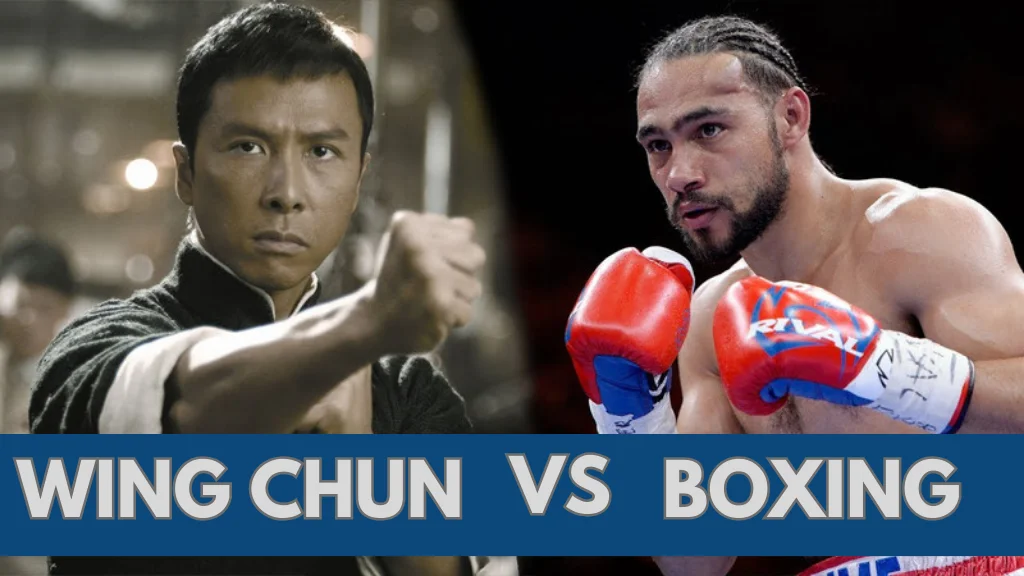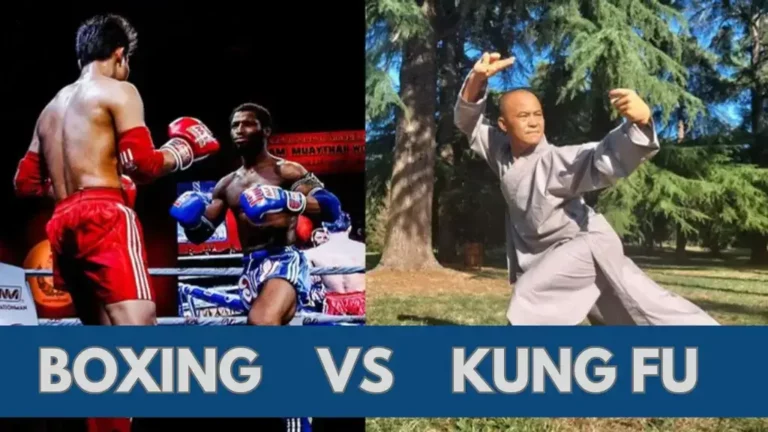Boxing and Wing Chun are renowned martial arts with their unique styles and techniques. These disciplines have amassed passionate followings, each championing the effectiveness of their chosen martial art. In this comprehensive exploration, we will delve into the world of boxing and Wing Chun, uncovering the nuances that set them apart, the benefits they offer, and how they measure up against one another.
Boxing vs. Wing Chun Understanding the Differences
When it comes to martial arts, Boxing and Wing Chun stand out as distinct disciplines, each carrying its own rich history, philosophy, and set of techniques. Understanding the differences between these two martial arts is essential for anyone considering training in either. This knowledge can help individuals make an informed choice that best aligns with their personal goals, physical capabilities, and self-defense needs.
Boxing, often referred to as the “sweet science,” is a stand-up striking art that emphasizes powerful punches, precise footwork, and defensive maneuvers such as head movement. It is a sport that has evolved over centuries and has become deeply ingrained in competitive athletics worldwide. On the other hand, Wing Chun is a traditional Chinese martial art developed for close-quarters combat. It focuses heavily on rapid strikes, trapping, and controlling an opponent’s limbs to create openings for decisive attacks. Unlike boxing, Wing Chun practitioners thrive in confined spaces where distance management is minimal and quick reflexes dominate.
Fighting Styles
Boxing’s fighting style centers on striking with the fists while maintaining a strategic distance from the opponent. A boxer’s footwork plays a crucial role, allowing them to circle, advance, or retreat efficiently to exploit openings and avoid incoming strikes. The stance and head movement are designed to protect vulnerable areas and create counter-attack opportunities. This combination of offense and defense forms the foundation of boxing’s effectiveness in both sport and self-defense scenarios.
Conversely, Wing Chun’s fighting style is characterized by its commitment to close-range combat. Wing Chun fighters aim to neutralize their opponents quickly through a blend of blocking, parrying, trapping, and rapid-fire punches targeted at vital points. The goal is to control the opponent’s arms, restricting their ability to strike effectively while simultaneously delivering disabling counters. This approach makes Wing Chun especially practical for street self-defense and situations where the fighter has limited space to maneuver.
Techniques and Strategies
The techniques and strategic execution of boxing and Wing Chun reveal the martial arts’ core philosophies. Boxing boasts a diverse arsenal of punches, including the jab, cross, hook, and uppercut. These punches are often combined in fluid sequences that allow the boxer to create openings and maintain offensive pressure. Defensive techniques such as slips, rolls, and parries also play a significant role in a boxer’s toolkit, helping them avoid damage while setting up counterattacks.
Wing Chun’s techniques, while less varied in terms of punching styles, are highly specialized. The martial art relies on straight punches delivered in rapid succession, emphasizing speed and economy of motion. The hallmark of Wing Chun is its trapping methods, which involve intercepting and controlling the opponent’s limbs to disrupt their attack rhythm. This method allows practitioners to close distance quickly and transition into grappling or joint manipulation, turning the tide of a fight in tight quarters.
Training Methods
Training regimens for boxing and Wing Chun differ considerably, reflecting their distinct technical demands and combat philosophies. Boxers typically undergo intense physical conditioning that includes cardiovascular training, heavy bag work, mitt drills, and sparring. Cardiovascular conditioning is crucial in boxing because fights demand sustained bursts of energy and quick recovery. Heavy bag and mitt work sharpen punching power, accuracy, and timing, while sparring provides practical experience against resisting opponents.
Wing Chun training is more focused on developing sensitivity and reflexes through drills such as chi sao, or “sticking hands,” which trains tactile responsiveness and the ability to read an opponent’s movements instinctively. This practice develops a heightened sense of touch and timing, allowing practitioners to adapt quickly during close combat. Wing Chun also incorporates forms practice and wooden dummy training, which enhance technique precision, structural alignment, and muscle memory.
The Benefits of Boxing
Boxing extends its influence far beyond sport, offering comprehensive benefits that contribute to physical fitness, mental well-being, and practical self-defense skills. One of the most celebrated advantages of boxing is its improvement of cardiovascular fitness. The high-intensity nature of boxing training involving skipping, shadowboxing, pad work, and sparring — elevates the heart rate and improves lung capacity, resulting in enhanced stamina and endurance. Many fitness enthusiasts adopt boxing routines to achieve rigorous cardiovascular workouts that also build strength and agility.
In addition to cardiovascular improvements, boxing significantly enhances hand-eye coordination. The precise timing and accuracy required to execute effective punches translate into improved dexterity and spatial awareness. This improved coordination is beneficial not only in athletic endeavors but also in everyday tasks requiring fine motor skills.
Boxing also offers effective self-defense skills. The ability to deliver powerful, well-timed punches and to evade or block incoming attacks can provide a significant advantage in real-life confrontations. Learning boxing instills confidence, teaching practitioners how to maintain composure and respond assertively under pressure. This mental toughness is as valuable as physical prowess, empowering individuals to protect themselves and others.
The Benefits of Wing Chun
Wing Chun is widely celebrated for its practical self-defense techniques and its emphasis on efficiency and directness. The martial art’s approach prioritizes effectiveness in real-world confrontations over flashy or overly complex moves. Because Wing Chun specializes in close-range combat, it equips practitioners to handle aggressive opponents in confined spaces, such as crowded urban environments or inside vehicles.
Training in Wing Chun also sharpens reflexes and cultivates sensitivity. The chi sao practice is fundamental in developing an acute awareness of an opponent’s intentions, allowing the practitioner to anticipate and neutralize attacks before they fully materialize. This heightened tactile sensitivity trains not only the body but also the mind, fostering mental agility and quick decision-making.
A less often discussed but significant benefit of Wing Chun training is the growth in self-confidence. As practitioners master its efficient techniques and recognize their ability to control hostile situations, they experience a boost in personal assurance. This confidence positively impacts many areas of life, including social interactions, career performance, and overall psychological resilience.
Boxing vs. Wing Chun: A Comparative Analysis
Choosing between Boxing and Wing Chun ultimately depends on an individual’s specific needs, goals, and preferences. Both martial arts offer distinct advantages, and understanding these differences can guide prospective students toward the right discipline.
In terms of effectiveness in self-defense, Wing Chun holds a clear edge in close-quarters situations. Its emphasis on rapid strikes, trapping, and controlling the opponent makes it well-suited for environments where space is limited, and quick reflexes are critical. Boxing, while also effective for self-defense, excels when there is enough room to employ powerful, precise strikes and maintain distance. The boxer’s skill set is invaluable in scenarios requiring strong offensive capability and movement.
When evaluating fitness and conditioning, boxing shines due to its intensive cardiovascular workouts and physical demands. Boxers often develop exceptional stamina, endurance, and muscle tone, making the sport highly attractive for those seeking overall physical improvement. Wing Chun provides benefits that are more nuanced, focusing on agility, reflex development, and strength specific to close combat. While it may not offer the same aerobic intensity as boxing, Wing Chun improves body mechanics and coordination in unique ways.
Competitive opportunities also distinguish these martial arts. Boxing has a well-established competitive framework with professional and amateur bouts regulated by weight classes and governing bodies worldwide. This competitive aspect fosters discipline, mental fortitude, and sportsmanship, offering practitioners a platform to test their skills in real combat. Wing Chun, traditionally, is less oriented toward competition, focusing more on personal mastery and practical application. While tournaments and demonstrations exist, Wing Chun’s core philosophy remains rooted in self-defense and internal development rather than sport.
Combining Boxing and Wing Chun
In the modern martial arts landscape, many practitioners recognize the benefits of cross-training and blending techniques from different disciplines. Combining Boxing and Wing Chun can yield a versatile and comprehensive skill set that enhances both striking power and close-quarters adaptability.
Boxing provides practitioners with refined striking skills, emphasizing punches that are delivered with speed, accuracy, and power. This foundation in stand-up combat builds a solid platform for offense and defense. Wing Chun, with its focus on trapping, rapid strikes, and controlling an opponent’s limbs, complements boxing by addressing the critical aspects of close-range fighting.
When merged, these martial arts create a synergy where the practitioner can effectively control distance, deliver precise strikes from afar, and transition seamlessly into close combat when necessary. The integration of boxing’s footwork and head movement with Wing Chun’s tactile sensitivity and trapping techniques prepares the martial artist for a broad spectrum of self-defense scenarios. This adaptability is invaluable in unpredictable confrontations where conditions can shift rapidly.
The Ultimate Goal
The ultimate aim of combining Boxing and Wing Chun is to develop a martial artist who is both powerful and adaptable. Possessing the striking expertise and agility of a boxer, along with the efficiency and control of a Wing Chun practitioner, creates a formidable skill set. This dual competency enhances the ability to respond effectively to diverse threats, providing confidence and capability in various real-life situations.
Conclusion
The debate of Boxing vs. Wing Chun does not lend itself to a definitive winner. Both martial arts carry unique strengths and offer profound benefits depending on the context in which they are applied. Your choice between the two should be guided by your individual objectives, whether they be competitive sport, fitness, self-defense, or personal growth.
Whether you are drawn to the scientifically honed punches and athletic rigor of boxing or the close-quarters precision and practicality of Wing Chun, training in either discipline offers valuable insights into the martial arts world and contributes meaningfully to your physical and mental development.
FAQs
Which is more effective in self-defense, boxing or Wing Chun?
Both martial arts can be highly effective depending on the situation and the practitioner’s skill level. Boxing excels at stand-up striking, while Wing Chun is superior in close-quarters scenarios.
Can I practice both boxing and Wing Chun simultaneously?
Yes, many martial artists integrate elements from both disciplines to develop a more versatile and adaptive fighting style.
Is Wing Chun suitable for competitive sports?
Wing Chun is traditionally less focused on competition compared to boxing. Its primary emphasis remains on practical self-defense and personal mastery.
Related Post:




